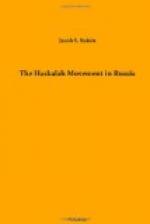To do his work thoroughly, the abbe deemed it advisable to write a preliminary dissertation, presenting his aim and views. This he did in his Theory of Judaism (Theorie du judaisme, Paris, 1830). He endeavored to show how worthless, injurious, and immoral were the teachings of the Talmud. Only by discarding them would the Jews qualify themselves to enjoy the right of citizenship. He proved, to his own satisfaction, that ritual murder was enjoined in the Talmud, and this he did at a time when many a community was harassed by this fiendish accusation. When early death cut short the abbe’s effort (1832), the Government, still persisting in its plans, engaged the services of Ephraim Moses Pinner of Posen, who published specimens of his intended translation in his Compendium (Berlin, 1831). But the fickle or restless emperor seems to have tired of the plan, or perhaps he found Pinner too Jewish for his purposes. Of the twenty-eight volumes planned, only one, which was dedicated to Nicholas, appeared during the decade following Chiarini’s death, and the work was abandoned entirely.[39]
The crusade against the Talmud, thus headed and backed by the Government, now broke out in all its fury. Anti-Talmudic works in English, French, and German were imported into Russia, translated into Hebrew, and scattered among the people. The Old Paths, by Alexander McCaul, a countryman and colleague of Lewis Way, but surpassing him in zeal for the conversion of Jews, was translated into Hebrew and German (Frankfort-on-the-Main, 1839) for the edification of those who knew no English. Jews themselves, either out of revenge or because they sought to ingratiate themselves with the high authorities, joined the movement, and openly came out against the Talmud in works modelled after Eisenmenger’s Entdecktes Judenthum. Such were Buchner, author of Worthlessness of the Talmud (Der Talmud in seiner Nichtigkeit, 2 vols., Warsaw, 1848), and Temkin, who wrote The Straight Road (Derek Selulah, St. Petersburg, 1835). The former was instructor in Hebrew and Holy Writ in the rabbinical seminary in Warsaw; the latter was a zealous convert to the Greek Catholic faith, who spared no effort to make Judaism disliked among his former coreligionists.
All these desperate attempts proved of no avail. Judaism was practiced, and the Talmud was studied during the reign of Nicholas I more ardently than ever before. Their sacred treasures attacked by the Government without and by renegades and detractors within, the Russian Jews nevertheless clung to them with a tenacity unparalleled even in their own history. Danzig’s Life of Man (Hayye Adam, Vilna, 1810), containing all Jewish ritual ceremonies, was followed out to the least minutiae. Despite the poverty of the Jews and the comparatively exorbitant price the publisher had to charge for the Talmud, and, aside from the many sets of former editions in the




